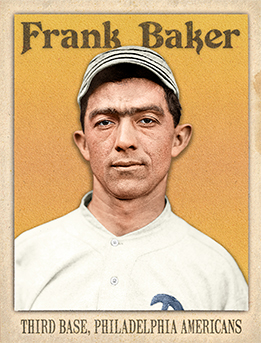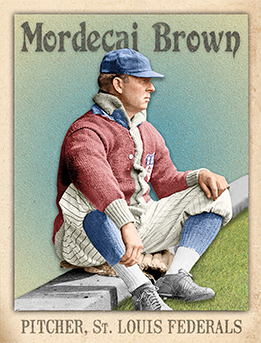- Series: Diamond Heads '15
- City: Philadelphia
- Team: Athletics (AL)
- League: American League
- Hall: National Baseball Hall of Fame
John Franklin Baker (1886-1963) was released by his minor league mgr who declared he “could not hit.” Connie Mack needed a 3rd baseman and gave Baker a try at the end of the 1908 season. Baker played 13 years exclusively at 3rd. He wielded his 52-oz bat like no other in the dead ball era.
- Led the AL in HRs 4 straight years for the Athletics
- Helped Connie Mack’s team to 3 Series victories, closed his career with Babe Ruth’s Yankees
- Elected to Hall of Fame: 1955
- Series: Diamond Heads '15
- City: Philadelphia
- Team: Athletics (AL)
- League: American League
- Hall: National Baseball Hall of Fame
Charles Albert Bender (1884-1954) won 212 games en route to a Hall of Fame career. He began life amid the abject poverty of a Minnesota reservation, was mentored by Pop Warner at the Carlisle Indian School and hit the majors with a bang for the Athletics in 1903. “Albert” as Connie Mack called him, beat future Hall members Cy Young and Clark Griffith compiling 17 wins in his rookie season. He led the league 3x in win percentage but was at his best under pressure. In 5 World Series, Bender won 6 games with a 2.44 ERA and completed 9 of his 10 starts.
- Connie Mack said that of all his players he would most trust Bender to win in the clutch
- Admired for his brilliance, Ty Cobb dubbed him the most intelligent pitcher he ever faced
- Elected to Hall of Fame: 1953
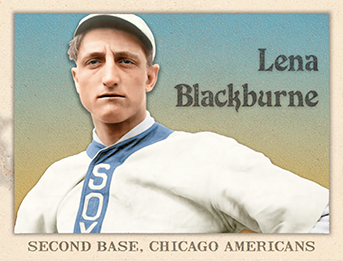
- Series: Diamond Heads '15
- City: Chicago
- Team: White Sox
- League: American League
Russell Aubrey Blackburne (1886-1968) was no great shakes as a player and had a sub-.500 career as a manager. Not many with a lifetime .214 average get mentioned at Cooperstown. But Lena had a bulldog spirit and a zeal to improve one key aspect of baseball: the sheen on the balls themselves. Until Blackburne’s “Rubbing Mud,” balls were doctored with tobacco juice, Shinola, and whatever the local swamps provided, all in an attempt to take some of the manufacturer’s shine off the spheres. Lena found a solution that still serves the game today. True to his discoverer’s spirit, he kept secret the source of the clay from which he made the rubbing compound. It was believed to be a spot on the Delaware River near his home. Blackburne had played for the White Sox, Reds, Braves, and Phillies before coaching and managing for the Sox, Browns and Athletics. He was enough of an AL-partisan to restrict use of his wonder-mud to the American League until the mid-1950s when the NL at last could partake.
- No other compound improved the grip on the ball without damage to the horsehide
- No one has gotten rich from the Mud. Team’s can get by with one 32-oz container per season at a cost of about $60. The current vendor of Blackburne’s concoction has to work full-time to support his family
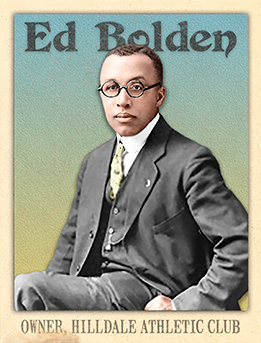
- Series: Diamond Heads '15
- City: Darby
- Team: Hilldale Athletic Club
- League: Independent
Edward Bolden (1881-1950) was one of the most successful entrepreneurs in black baseball in the early 20th century. Though it sounds dissonant to the contemporary ear, Bolden proudly declared himself a “race man” and boldly promoted his club as one owned and operated by other race men. This was in opposition to overtures and intimidations of white impresarios seeking to horn in on the growing popularity of negro ball in the 1920s. Bolden was always a keen recruiter of talent and his reputation for black-ownership attracted some of the best to his teams including Louis Santop, Smoky Joe Williams and Dick Lundy. Ed cut his showman's teeth with the Hilldale Club of Darby PA, bringing solid management and a zeal for rectitude on and off the field. He banned alcohol and demanded decorum from his players. He even enforced discipline among the fans and brought in security when needed. Conflicts with Rube Foster over accusations of poaching by Bolden, coupled with high operating costs especially for travel, led Bolden to leave the Negro National League for the Eastern Colored League in 1922. The two superstars of black league management faced off in the first Colored World Series in 1924 with Foster's KC Monarchs triumphant. Bolden's squad got revenge the following year.
- Black teams always ran on a shoestring and as the economy worsened in the late '20s and plunged in the Depression, Bolden left the game temporarily.
- He returned to lead clubs through the war years and the cusp of integrated ball he earnestly desired to see. He was the last of the breed of early black ownership upon his death in 1950
- Series: Diamond Heads '15
- City: Chicago
- Team: Cubs
- League: National League
- Hall: National Baseball Hall of Fame
Roger Bresnahan (1879-1944) played every position but came into his own as a lead-off-hitting catcher and battery mate to Christy Mathewson for John McGraw’s Giants. Innovation took guts in a rowdy era and he had the fortitude to introduce shin guards, batting helmets and padded masks over the protests of other clubs and the pelting of irate fans (who didn’t have to catch Mathewson.)
- Batted .350 in 1903, trailing only Honus Wagner’s .355 and Fred Clarke’s .351
- Elected to Hall of Fame the year after his death: 1945
- Series: Diamond Heads '15
- City: St. Louis
- Team: Terriers
- League: Federal League
- Hall: National Baseball Hall of Fame
Mordecai Peter Centennial Brown (1876-1948) gained the Hall of Fame on the strength of a wicked curve, enhanced by childhood accidents that cost him parts of two fingers on his “twirling” hand. He won 20+ for the Cubs six times from 1904-12 with two world championships.
- Career record of 239-130 and the 3rd best ERA of all time: 2.06
- Had legendary duels with Giants’ Christy Mathewson, and went 13-11 against him
- His 2.06 ERA is best ever by a pitcher with more than 200 wins
- Elected to Hall of Fame: 1949
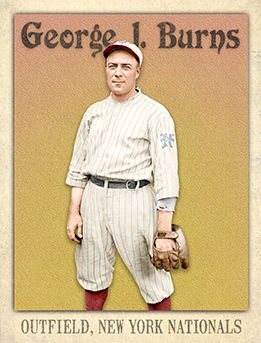
- Series: Diamond Heads '15
- City: New York
- Team: Giants
- League: National League
George Joseph Burns (1889-1966) was dubbed by his teammates “Silent George” for his reserved, soft-spoken manner. He might as well have been named “Anonymous George” as one of the greatest outfielders of his generation of whom few remember today. He retired holding records for leading the National League in runs scored five times, a Giants' club single-season record for steals (62) that still stands, and top-ten ranking in games played and games in the outfield in MLB. The Utica native debuted with McGraw's crew in 1911 and George quickly found a home in left at the Polo Grounds, mastering its odd angles and even conquering the dazzling afternoon glares, prompting scribes to dub the area Burnsville. He was one of the first to don sunglasses and his mates later described him as “the 'greatest sun fielder' in the history of the game.” Only Rogers Hornsby exceeded George's total bases in 1917 and it wasn't till Willie Mays 53 years later in 1972 that his career stolen base record for the Giants would be eclipsed. His last hurrah in NY was the 1921 Series. The team hadn't won in October since 1905 and George hadn't performed well in his previous attempts at post-season glory. But '21 proved triumphant for Burns and his team as they beat the Yankees in the first Series between teams sharing the same home field. Babe Ruth had been phenomenal in the regular season but was hurt during the post-season and George got to wear the laurel wreath.
- A renowned amateur boxer and wrestler, the diminutive Burns never backed down from invitations to grapple with his much more physically formidable teammate Jim Thorpe
- Growing up in his father's pool hall, Burns was a world-class pool player, but teammates wouldn't play with him unless he agreed to play left-handed
- McGraw traded Burns to the Reds two months after the '21 World Series for Heinie Groh, but the speedy Burns wasn't through. He set an NL record with his 28th steal of home in 1922
- In fifteen ML seasons, Burns' 2,077 hits produced a .287 career average and only Musial and Hornsby equaled his feat of leading the NL five-times in runs record
